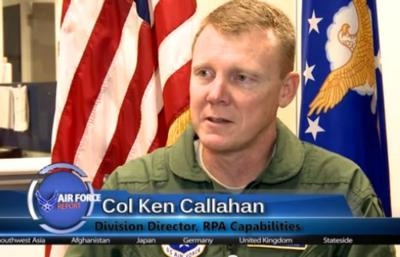Tue, Apr 08, 2014
Twenty-Five-Year Vision For RPAs Gives Private Sector Guidance For Manufacturing
Air Force leaders outlined what the next 25 years for remotely piloted aircraft will look like in the RPA Vector, published April 4. “The RPA Vector is the Air Force’s vision for the next 25 years for remotely-piloted aircraft,” said Col. Kenneth Callahan, the RPA capabilities division director. “It shows the current state of the program, the great advances of where we have been and the vision of where we are going.”

The goal for the vector on the operational side is to continue the legacy Airmen created in the RPA field. The vector is also designed to expand upon leaps in technology and changes the Airmen have made through the early years of the program. “The Airmen have made it all about supporting the men and women on the ground,” Callahan said. “I couldn’t be more proud of them for their own advances in technology to expand the program, making it a top platform.”
The document gives private corporations an outlook on the capabilities the Air Force wants to have in the future, ranging from creation of new RPAs to possibilities of automated refueling systems. “There is so much more that can be done with RPAs,” said Col. Sean Harrington, an intelligence, surveillance, and reconnaissance command and control requirements chief. “Their roles (RPAs) within the Air Force are evolving. We have been able to modify RPAs as a plug-and-play capability while looking to expand those opportunities.”
In recent years, RPAs not only supported the warfighter on the ground, they also played a vital role in humanitarian missions around the world. They provided real time imagery and video after the earthquake that led to a tsunami in Japan in 2011 and the earthquake in Haiti in 2010, according to Callahan. Then, most recently, during the California Rim Fire in August 2013, more than 160,000 acres of land were destroyed. Though this loss was significant, it was substantially decreased by the support of the California Air National Guard’s 163rd Reconnaissance Wing, with support from an MQ-1 Predator, a remotely piloted aircraft.
With this vector, technologies may be created to improve those capabilities while supporting different humanitarian efforts, allowing the Air Force to support natural disaster events more effectively and timely.
The future of the Air Force’s RPA programs will be continuously evolving, to allow the Air Force to be the leader in Air, Space, and Cyberspace. “We already combine our air, space and cyber forces to maximize these enduring contributions, but the way we execute must continually evolve as we strive to increase our asymmetric advantage,” said Gen. Mark Welsh, the Air Force chief of staff. “Our Airmen's ability to rethink the battle while incorporating new technologies will improve the varied ways our Air Force accomplishes its missions.”
(Image provided by the U.S. Air Force)
ANN Salutes Staff Sgt. Carlin Leslie, Air Force Public Affairs Agency
More News
Aero Linx: Model Aeronautical Association of Australia MAAA clubs are about fun flying, camaraderie and community. For over 75 years, the MAAA has been Australia’s largest fl>[...]
Touchdown Zone Lighting Two rows of transverse light bars located symmetrically about the runway centerline normally at 100 foot intervals. The basic system extends 3,000 feet alon>[...]
“Discovery and innovation are central to our mission at Virgin Galactic. We’re excited to build on our successful record of facilitating scientific experiments in subor>[...]
How To Get A Story On Aero-TV News/Feature Programming How do I submit a story idea or lead to Aero-TV? If you would like to submit a story idea or lead, please contact Jim Campbel>[...]
Student Pilot Reported That During Rotation, “All Of A Sudden The Back Of The Plane Kicked To The Right..." Analysis: The student pilot reported that during rotation, “>[...]
 ANN's Daily Aero-Linx (05.02.24)
ANN's Daily Aero-Linx (05.02.24) ANN's Daily Aero-Term (05.02.24): Touchdown Zone Lighting
ANN's Daily Aero-Term (05.02.24): Touchdown Zone Lighting Aero-News: Quote of the Day (05.02.24)
Aero-News: Quote of the Day (05.02.24) ANN FAQ: Contributing To Aero-TV
ANN FAQ: Contributing To Aero-TV NTSB Final Report: Cirrus Design Corp SR20
NTSB Final Report: Cirrus Design Corp SR20



